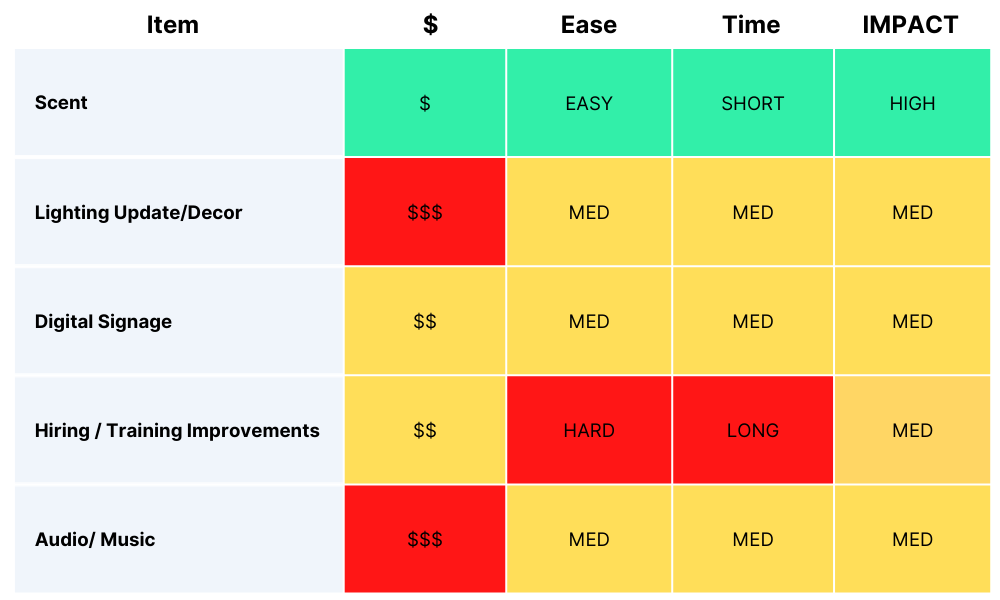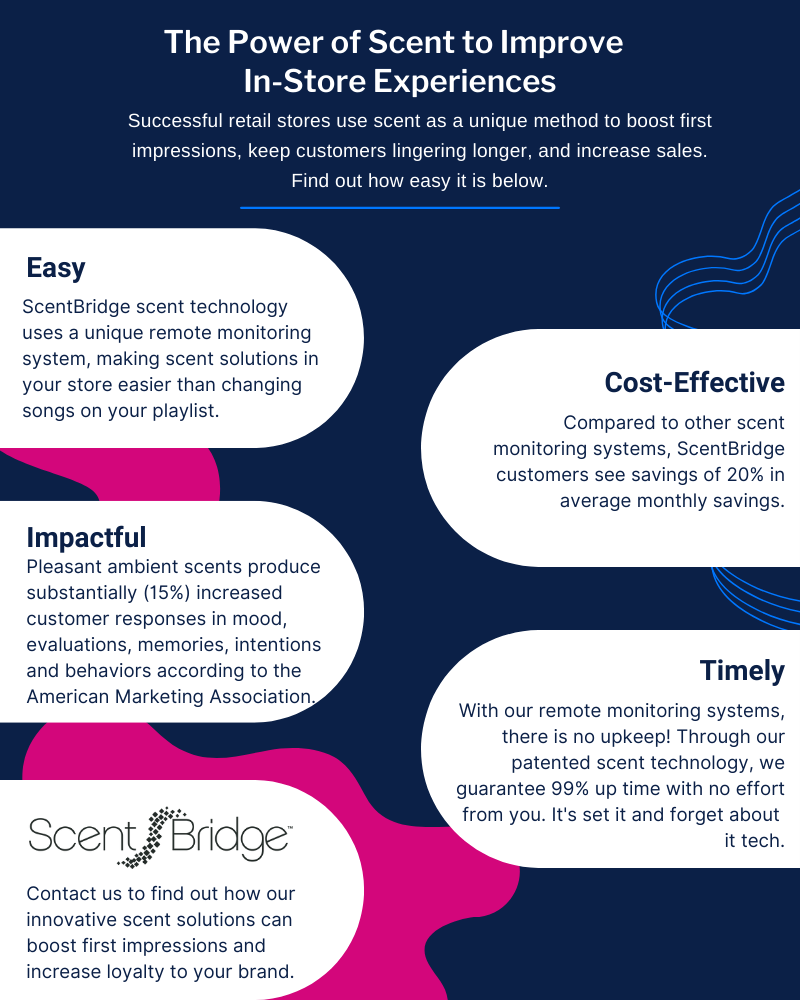Are you looking to improve the in-store experience for your customers?
The scent of your space strongly impacts your everyday operations. Because of this, you need the best, most reliable technology. A disruption in scent can negatively impact your customer’s experience. If scent stops working due to an equipment malfunction or depletion of scent, it could be weeks before the supplier arrives on-site to fix the problem. Meanwhile, your calming, relaxing atmosphere takes a back seat, and distracting odors become more noticeable. As a result, customers might choose not to stay as long.
Remember: Your customers more powerfully experience your space through their sense of smell than any of their other senses!
Scent
Scent has a significant impact on consumer behavior. It is one of the most powerful tools for influencing consumer decision-making. By using scents in your retail store, you can improve customers’ moods, increase their willingness to spend, and make them more likely to return.
Smell impacts the prefrontal cortex, the part of the brain responsible for decision-making. Not only does a pleasant scent promote relaxation, but it also increases dopamine production for a more pleasurable experience. According to a study by the International Journal of Marketing, consumers exposed to pleasant smells are willing to pay up to 20% more for products than those who aren’t exposed to a pleasant smell.
This close link between smell and decision-making has been proven time and again: when people are exposed to pleasant smells in a retail environment, they’re more likely to spend more time shopping. Pleasant scents can also make consumers feel less anxious about trying new products.
The sense of smell is often described as the most powerful of all five senses because it has a direct pathway to our emotional centers, bypassing the cognitive brain. Unlike other senses, which only stimulate one area of the brain (i.e. sight stimulates vision, sound stimulates hearing), scent receptors send signals to multiple areas of the brain that involve emotion and memory—including those involved with hunger, thirst, and excitement.
Scent marketing is also easy to employ. Scent systems used in retail stores make monitoring and controlling scent levels convenient. With powerful scent technology, choose your scent, set it, and forget it. Your in-store scent levels will be remotely monitored for you, saving you time with virtually no upkeep. The time required to pick out a scent is all it takes.
The cost of deploying scent marketing is relatively low in comparison to the methods we discuss below, lighting/decor, digital signage, and customer service improvements.
Click here to explore the retail scent machines that entice customers to spend more.
Lighting and Décor
Lighting is crucial to the in-store experience. The right amount can impact how customers perceive a store. Lighting can make a space feel warm and inviting or cold and sterile. The right lighting can help customers feel more relaxed and comfortable. Decor can either make or break a store’s atmosphere, depending on the way it’s used. It can set the tone for the store and give customers an idea of what kind of experience they’re about to have before they even step inside.
Lighting and décor are certainly important, although they require significant planning, labor, and expense. These techniques are also single-dimensional (visual-only improvements) in comparison to smell which is multidimensional.
Digital Signage
Digital signage can be used to deliver targeted messages to consumers. If you know there will be an increase in customers at your store during lunchtime, your digital signage can be customized with a unique offer appropriate to that time of day.
Digital signage may be less expensive than lighting and decor, but it requires more upkeep. Your employees will need to update it in a timely manner and ensure it remains relevant to your products and customer needs. The impact of digital signage may also be minimal in improving the overall in-store experience, as it is focused more on relaying information about sales rather than improving the actual shopping experience.
Customer Service
Strong customer service is certainly key to a great in-store experience. One of the most common reasons customers leave a store without making a purchase is poor customer service. Studies have found up to 70% of the buying experience is based on how customers feel they are being treated.
Enhancing customer service through improved hiring and training practices requires significant time and resources. Retail stores are often short-staffed, leaving the quality of customer service at the mercy of the employees who showed up to work that day. Improving customer service in your store will certainly make a large impact, but it is far from a quick and easy technique to improve the in-store customer experience.
The last method to improve the in-store retail experience we’ll cover is the use of music.
Music
Music can help create an atmosphere that makes people feel comfortable and relaxed—or excited and energized—depending on the type of music played. This, in turn, assists shoppers in feeling at ease, making them more likely to explore and stay longer. Moreover, music can be relatively inexpensive and require minimal upkeep. However, the overall impact of music is low when compared to scent. In fact, the cost and effort required for both music and scent are similar, but the impact of scent is far greater.
Scent – An Easy, High Impact, and Cost-Effective Way to Improve In-Store Experiences
Consider these 5 methods for improving the in-store experience of your retail store. Each method is subtle yet effective in influencing consumer decision-making with varying levels of impact, cost, ease and time to implement.
The multidimensional benefits of scent make it the most impactful, low-cost way to improve your retail brand.
Influence customers to linger longer, make more purchases, and feel positively about your brand experience by incorporating scent into your marketing strategy.



